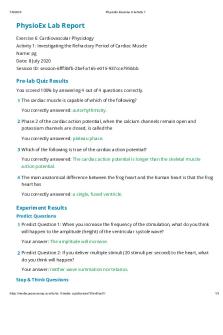Physio Ex Exercise 6 Activity 5 PDF

| Title | Physio Ex Exercise 6 Activity 5 |
|---|---|
| Author | Kyleigh Hankton |
| Course | Human Anatomy Laboratory |
| Institution | Alcorn State University |
| Pages | 4 |
| File Size | 212.1 KB |
| File Type | |
| Total Downloads | 115 |
| Total Views | 270 |
Summary
PhysioEx Lab ReportExercise 6: Cardiovascular Physiology Activity 5: Examining the Effects of Various Ions on Heart Rate Name: Kyleigh Hankton Date: 13 February 2021 Session ID: session-b7bf5818-37e8-30ee-c507-19a6b906fPre-lab Quiz ResultsYou scored 100% by answering 4 out of 4 questions correctly.E...
Description
2/13/2021
PhysioEx Exercise 6 Activity 5
PhysioEx Lab Report Exercise 6: Cardiovascular Physiology Activity 5: Examining the Effects of Various Ions on Heart Rate Name: Kyleigh Hankton Date: 13 February 2021 Session ID: session-b7bf5818-37e8-30ee-c507-19a6b906f745
Pre-lab Quiz Results You scored 100% by answering 4 out of 4 questions correctly. 1 Which organelle in the cardiac muscle cell stores calcium? You correctly answered: sarcoplasmic reticulum. 2 Verapamil is a calcium-channel blocker. Its effects could be described as You correctly answered: negative chronotropic and negative inotropic. 3 When the cardiac muscle cell is at rest, where is most of the potassium found? You correctly answered: in the cytosol. 4 Resting cardiac muscle cells are most permeable to You correctly answered: potassium.
Experiment Results Predict Questions 1 Predict Question 1: Because calcium-channel blockers are negative chronotropic and negative inotropic, what effect do you think increasing the concentration of calcium will have on heart rate? Your answer: positive chronotropic, positive inotropic. 2 Predict Question 2: Excess potassium outside of the cardiac cell decreases the resting potential of the plasma membrane, thus decreasing the force of contraction. What effect (if any) do you think it will initially have on heart rate? Your answer: decrease heart rate. Stop & Think Question 1 Where in the cardiac muscle cell is most of the sodium normally found? https://media.pearsoncmg.com/bc/bc_0media_ap/physioex/10/ex6/act5/
i 1/4
2/13/2021
PhysioEx Exercise 6 Activity 5
You correctly answered: outside of the cell. Experiment Data Solution
Heart Rate (beats/min)
----
60
Calcium
70
Sodium
~34
Potassium
~28
i https://media.pearsoncmg.com/bc/bc_0media_ap/physioex/10/ex6/act5/
2/4
2/13/2021
PhysioEx Exercise 6 Activity 5
Post-lab Quiz Results You scored 100% by answering 4 out of 4 questions correctly. 1 The addition of most of the ions resulted in You correctly answered: an erratic, decreased heart rate. 2 The effect of potassium on the heart is You correctly answered: negative chronotropic, negative inotropic. 3 The ion that had the most pronounced effect on heart rate was You correctly answered: potassium. 4 Ectopic pacemakers can be caused by excessive leakage of potassium into cardiac cells, resulting in pacemakers appearing in abnormal locations in the heart muscle. This
hyperkalemia (excess potassium) decreases the resting potential of the cardiac muscle cell. What effect do you think this would have on the force of contraction? You correctly answered: decrease, negative inotropic.
Review Sheet Results 1 Describe the effect that increasing the calcium ions had on the heart in this activity. How well did the results compare with your prediction? Your answer: As predicted, due to the increased heart rate and contraction pressure, the blood goes faster. i https://media.pearsoncmg.com/bc/bc_0media_ap/physioex/10/ex6/act5/
3/4
2/13/2021
PhysioEx Exercise 6 Activity 5
2 Describe the effect that increasing the potassium ions initially had on the heart in this activity. Relate this to the resting membrane potential of the cardiac muscle cell. How well did the results compare with your prediction? Your answer: As predicted, high potassium ions decrease the resting potential and pressure of contraction. 3 Describe how calcium channel blockers are used to treat patients and why? Your answer: In all paths of action potential, they block the movement of calcium through the channels. Decreased calcium causes decreased heart rate and pressure of contraction.
i https://media.pearsoncmg.com/bc/bc_0media_ap/physioex/10/ex6/act5/
4/4...
Similar Free PDFs

Physio Ex Exercise 5 Activity 6
- 3 Pages

Physio Ex Exercise 6 Activity 5
- 4 Pages

Physio Ex Exercise 5 Activity 6
- 3 Pages

Physio Ex Exercise 5 Activity 6
- 3 Pages

Physio Ex Exercise 6 Activity 5
- 4 Pages

Physio Ex Exercise 6 Activity 5
- 4 Pages

Physio Ex Exercise 5 Activity 5
- 3 Pages

Physio Ex Exercise 5 Activity 5
- 2 Pages

Physio Ex Exercise 5 Activity 5
- 3 Pages

Physio Ex Exercise 5 Activity 5
- 3 Pages

Physio Ex Exercise 6 Activity 1
- 3 Pages

Physio Ex Exercise 6 Activity 4
- 5 Pages

Physio Ex Exercise 6 Activity 4
- 5 Pages

Physio Ex Exercise 6 Activity 1
- 3 Pages

Physio Ex Exercise 6 Activity 3
- 3 Pages

Physio Ex Exercise 6 Activity 3
- 3 Pages
Popular Institutions
- Tinajero National High School - Annex
- Politeknik Caltex Riau
- Yokohama City University
- SGT University
- University of Al-Qadisiyah
- Divine Word College of Vigan
- Techniek College Rotterdam
- Universidade de Santiago
- Universiti Teknologi MARA Cawangan Johor Kampus Pasir Gudang
- Poltekkes Kemenkes Yogyakarta
- Baguio City National High School
- Colegio san marcos
- preparatoria uno
- Centro de Bachillerato Tecnológico Industrial y de Servicios No. 107
- Dalian Maritime University
- Quang Trung Secondary School
- Colegio Tecnológico en Informática
- Corporación Regional de Educación Superior
- Grupo CEDVA
- Dar Al Uloom University
- Centro de Estudios Preuniversitarios de la Universidad Nacional de Ingeniería
- 上智大学
- Aakash International School, Nuna Majara
- San Felipe Neri Catholic School
- Kang Chiao International School - New Taipei City
- Misamis Occidental National High School
- Institución Educativa Escuela Normal Juan Ladrilleros
- Kolehiyo ng Pantukan
- Batanes State College
- Instituto Continental
- Sekolah Menengah Kejuruan Kesehatan Kaltara (Tarakan)
- Colegio de La Inmaculada Concepcion - Cebu